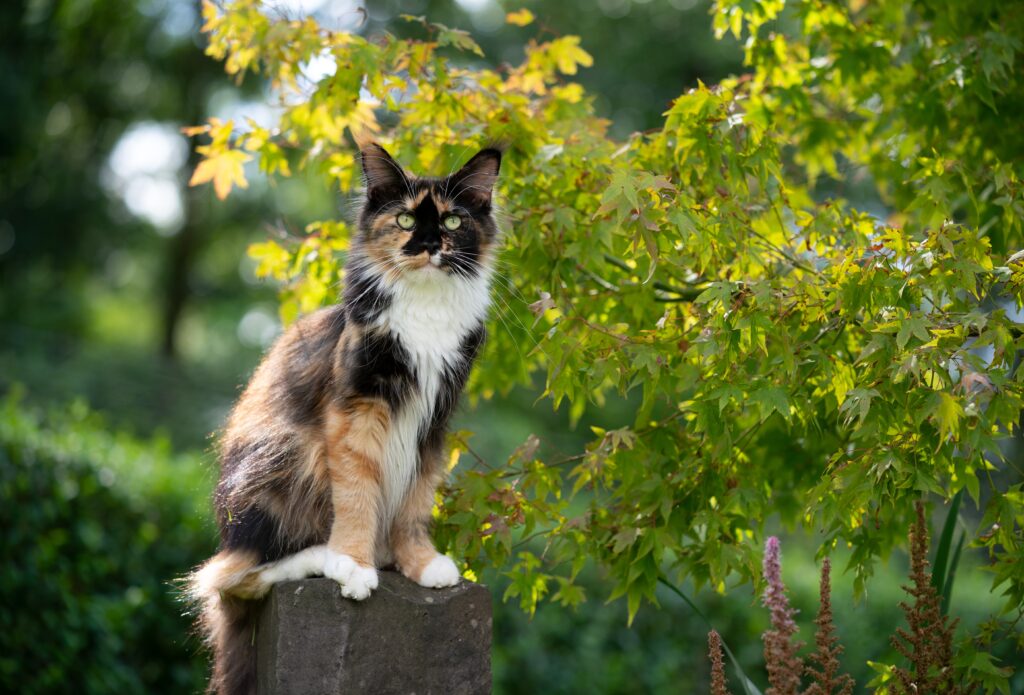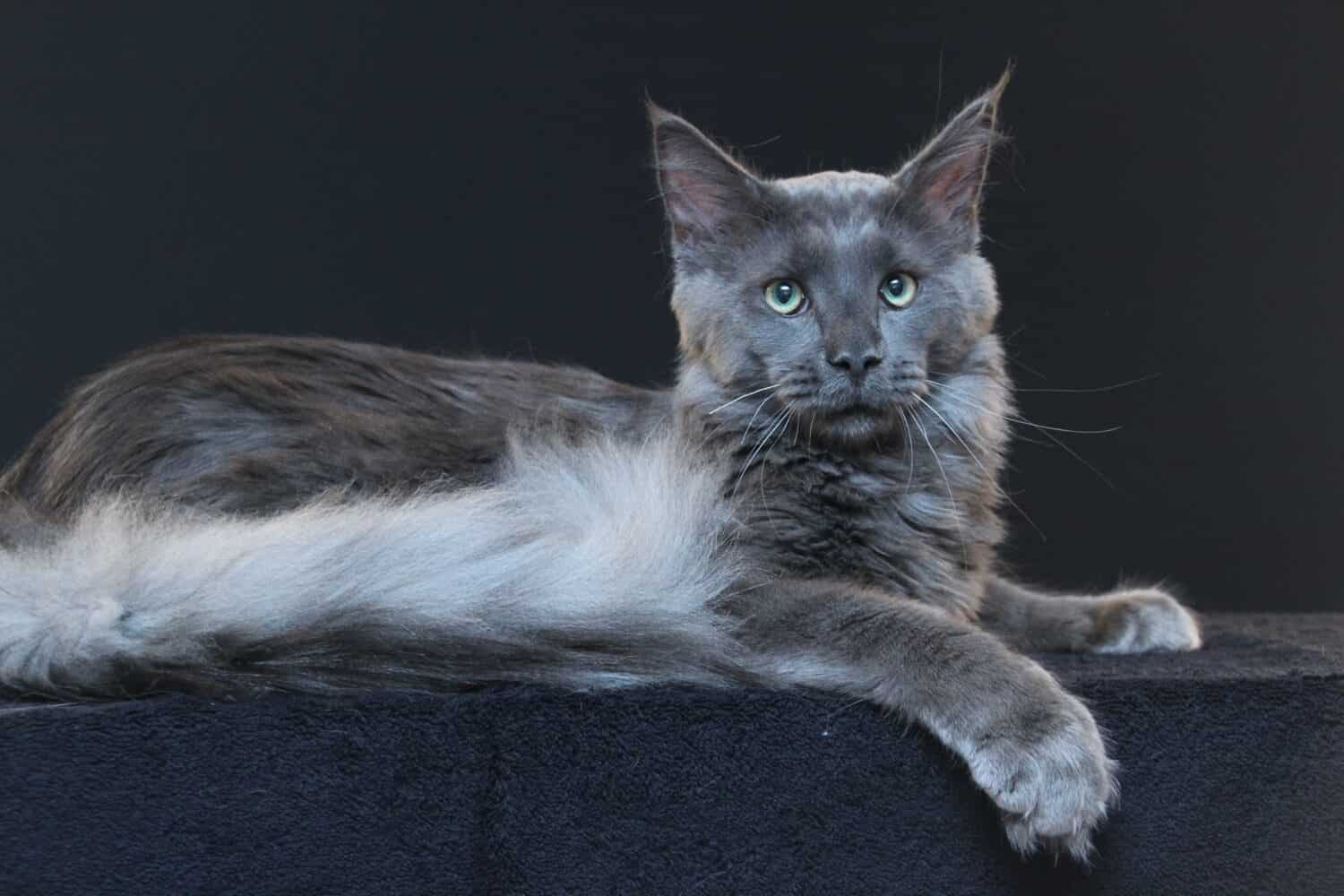Ah, the luxurious Maine Coon! Not only are they highly social, playful, affectionate, and intelligent, but they are also ravishingly beautiful. It’s almost unfair, really, how stunning they are. Known for their large, sturdy build, tall tufted ears, and almond-shaped, expressive eyes, they are the A-List celebrities of the feline world and sport a wide variety of colors and patterns! In fact, with 75 types recognized by the Cat Fanciers Association (CFA) – Maine Coons boast an impressive range of hues, tones, and styles in their coat variations. The astonishing diversity of Maine Coon cat colors – ranging from the rarest to the most common – is truly mesmerizing.
From the classic tabby to vibrant combinations like tortoiseshell and calico, their sumptuous, waterproof fur – made to survive winter weather – showcases patterns like stripes, spots, and swirls. With their bushy tails and prominent ruffs around their necks, Maine Coons are marvels of nature’s artistry. It is no wonder they are cherished and admired by cat enthusiasts worldwide. And it’s not only their physical appearance that makes them so beloved. These majestic beings also have a rich cultural and evolutionary history and stellar personalities.
For instance, because these cats – who originated in the Northeast in the 1800s – retain their kitten-like playfulness and agility even as they mature, Maine coons often captivate us with their curiosity and joyful antics. Inquisitive and quick to learn, they can easily be trained to perform tricks. Maine Coons are also highly social, forming strong bonds with humans and other animals – making them great family pets. Moreover, their natural inclination for adventure and exploration renders them adept climbers and curious explorers. They are likewise a bit quirky! Unlike many other cat breeds, for example, these whimsical creatures often enjoy water. Some may even dip their paws in water bowls or play with a running faucet. Frisky and energetic, Maine coons provide constant entertainment and love.
But I digress…
We are here to discuss Maine Coon cat colors, from the rarest to most common. So let’s explore the haute couture of these cats’ chic and elegant coats.
Feline Fashionistas
First, let’s examine several key categories – or color class groups – of Maine Coon coats. Beginning with the parti-color patterns that combine two or more colors, this stylish group includes tortoiseshells, calicos, bluecreams, and white/torties. Interestingly, due to their genetic makeup, female Maine Coons are much more likely to inherit these specific color fusions than males.

Calico Maine Coons are predominantly female due to their genetic makeup.
©Nils Jacobi/Shutterstock.com
Maine Coons who don two colors can also fit into the category of bi-color if their fur is white with a darker or contrasting color. These dichotomous combinations – such as black/white, blue/white, cream/white, and red (orange)/white – create a striking visual contrast and dazzle the eye.
Now let’s move onto to the tabbies, renowned for their charming stripes. The classic tabby design features swirls with a butterfly pattern on the shoulders, while the mackerel tabby displays elegant, narrow stripes. Additional tabby variations include spotted and ticked patterns, with the latter being especially exclusive. Another group, tabby with white markings, are similar and flaunt their intricate tabby designs alongside graceful white markings.

Tabbies often have butterfly patterns on their shoulders.
©pix-l passion/Shutterstock.com
Next, we have the smoked Maine Coons whose frosted appearance could give any Hollywood glam leading lady with smokey eye-shadow a run for her money. Their coats begin with a solid color at the base, then gradually lighten towards the tips, creating a smoky effect that adds depth and allure, and ultimately creates a aura of mystique.

Blue smoke Maine Coons are part of the smoked category and appear almost frosted.
©Ceoma/Shutterstock.com
Last but not least are the solids. While their coats may sound boring in comparison to the other categories, they are still quite bewitching. Pure and uniform in color – without any patterns or markings – solid Maine Coons showcase the brilliant essence of their individual hue in all of its splendor.

Solid Maine Coons are pure and uniform in color – without any patterns or markings.
©Nynke van Holten/Shutterstock.com
Rarest and Most Common
So out of the 75 recognized color groups…which will you see the least and which the most? Here is a chart with the three rarest and three most common colors of Maine Coons.
| Three Rarest | Reason | Three Most Common | Reason |
|---|---|---|---|
| Red (also called orange or ginger) | Just like with humans, it appears that solid red hair – or fur- is extremely rare in Maine Coons, too! Officially classified as “red” by the Cat Fanciers’ Association (CFA). In contrast to the fact that most calico Maine coons are female, reddish-orange cats are mostly male, also due to their genetics. | Tabby | Due to being a dominant gene, up to 80% of all cats, including Maine Coons, have tabby patterns. |
| Silver | These are genetically rare because both parents must carry the necessary genes to pass on to their offspring. | Black | The black color is controlled by a dominant gene, and since it only requires one copy of the gene from one parent to appear, it is more prevalent in the breed. |
| Shaded Silver | The genetic basis for both silver and shaded-silver color patterns involves the presence of the “inhibitor of the orange gene” or I gene. This restricts the expression of the orange color in the fur – and results in a silver appearance. However, the specific distribution of the silver color in shaded-silver Maine Coons is influenced by other genetic factors that regulate how the silver color is distributed on the cat’s body. | Blue | The dilution gene in cats reduces the intensity of the common black color – leading to a blue or gray appearance. Similar to black, blue requires only one copy of the dilution gene to be expressed, which makes these colors appear more often. |
The photo featured at the top of this post is © Andrew Will/Shutterstock.com
Thank you for reading! Have some feedback for us? Contact the AZ Animals editorial team.






